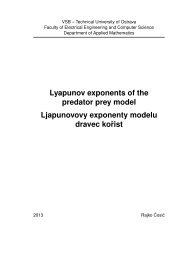The Boundary Element Method for the Helmholtz Equation ... - FEI VÅ B
The Boundary Element Method for the Helmholtz Equation ... - FEI VÅ B
The Boundary Element Method for the Helmholtz Equation ... - FEI VÅ B
You also want an ePaper? Increase the reach of your titles
YUMPU automatically turns print PDFs into web optimized ePapers that Google loves.
46 3 <strong>Boundary</strong> Integral <strong>Equation</strong>sSimilarly, applying <strong>the</strong> Neumann trace operator we get <strong>the</strong> Fredholm integral equation of<strong>the</strong> first kind(D κ γ 0,ext u)(x) = − 1 2 g N(x) − (K ∗ κg N )(x) <strong>for</strong> x ∈ ∂Ω. (3.51)andInstead of equations (3.50) and (3.51) we may consider <strong>the</strong> variational problemsrespectively.− 1 2 I + K κ γ 0,ext u, s = ⟨V κ g N , s⟩ ∂Ω <strong>for</strong> all s ∈ H −1/2 (∂Ω),∂Ω⟨D κ γ 0,ext u, t⟩ ∂Ω =− 1 2 I − K∗ κ g N , t∂Ω<strong>for</strong> all t ∈ H 1/2 (∂Ω), (3.52)<strong>The</strong> arguments <strong>for</strong> <strong>the</strong> unique solvability of <strong>the</strong> boundary integral equation (3.51) and<strong>the</strong> corresponding variational problem (3.52) <strong>for</strong> κ 2 not coinciding with an eigenvalue of(3.36) are <strong>the</strong> same as in Section 3.5.2.<strong>The</strong>orem 3.30. If u ∈ H 1 loc (Ωext , ∆ + κ 2 ) is a solution to <strong>the</strong> exterior Neumann problem(3.48), <strong>the</strong>n <strong>the</strong> Dirichlet trace γ 0,ext u satisfies <strong>the</strong> boundary integral equation (3.51) andu has <strong>the</strong> representation (3.49).Conversely, if γ 0,ext u satisfies <strong>the</strong> boundary integral equation (3.51), <strong>the</strong>n <strong>the</strong> representation<strong>for</strong>mula (3.49) defines a solution u ∈ H 1 loc (Ωext , ∆ + κ 2 ) to <strong>the</strong> interior Neumannproblem (3.48).Note that <strong>The</strong>orems 3.25 and 3.30 ensure that <strong>for</strong> all κ ∈ R + it holds− 1 2 I − K∗ κ g N ∈ Im D κand thus one of <strong>the</strong> methods mentioned at <strong>the</strong> end of <strong>the</strong> previous section can be used tocompute a solution to (3.51) with κ 2 coinciding with an eigenvalue of (3.36).3.5.6 Exterior Mixed <strong>Boundary</strong> Value ProblemFinally, let us consider <strong>the</strong> exterior mixed boundary value problem⎧⎪⎨⎪⎩ ∇u(x),x∥x∥∆u + κ 2 u = 0 in Ω ext ,γ 0,ext u = g D on Γ D ,γ 1,ext u = g N on Γ N , − iκu(x)1 = O ∥x∥ 2<strong>for</strong> ∥x∥ → ∞(3.53)









